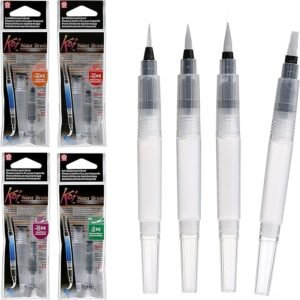Step-by-Step Guide for Using Papers
- Select the Right Paper: Choose the appropriate Canson paper for your medium (e.g., watercolor, sketching, mixed media).
- Prepare Your Tools: Gather all necessary art supplies such as pencils, brushes, and paints.
- Start with a Light Sketch: Use a pencil to lightly sketch your design on the paper.
- Apply Your Medium: Use the chosen medium, ensuring you adjust techniques based on the paper’s texture and weight.
- Layer Gradually: Build up layers of color or graphite gradually to avoid damaging the paper.
- Blend and Add Details: Use blending tools and fine brushes for detail work.
- Finish and Protect: Once finished, consider applying a fixative to protect your work, if applicable.
Types of Papers
- Watercolor Paper: Cold press, hot press, and rough textures.
- Sketching Paper: Lightweight and smooth for easy sketching.
- Mixed Media Paper: Suitable for a variety of mediums, durable and versatile.
Guide for Proper Use and Care
- Storage: Store paper in a flat, dry place to prevent warping and damage.
- Handling: Handle paper with clean hands to avoid transferring oils and dirt.
- Protection: Use fixatives or protective covers to preserve finished work.
How to Repair Damaged Paper
- Tears: Use archival tape to mend tears. Apply carefully to avoid further damage.
- Smudges: Lightly erase smudges with a kneaded eraser.
- Water Damage: Press between absorbent paper and weights to flatten and dry.
Using Papers on Non-Professional Surfaces
- Choose Wisely: For non-professional surfaces, select heavier weight papers.
- Preparation: Tape down paper edges to prevent warping during wet media applications.
- Layering: Work in light layers to avoid saturating and damaging the paper.
How to Make a Homemade Sketchbook
- Materials Needed: Quality paper, cardboard covers, binding materials.
- Assembly: Cut paper to size, align with covers, and bind using staples, thread, or glue.
How to Use Canson Papers Correctly
- Match Medium to Paper: Ensure you are using the correct type of paper for your chosen medium.
- Test and Experiment: Test techniques on a small piece of paper before applying to the main piece.
- Follow Manufacturer Guidelines: Use as recommended by Canson for best results.
Solving Problems with Paper
- Warping: Press under weights to flatten.
- Bleeding: Use heavier weight paper to prevent bleeding through.
- Smudging: Handle carefully and apply fixative if necessary.
How to Store Your Paper
- Flat Storage: Store paper flat to prevent curling and creasing.
- Dry Environment: Keep in a dry, cool place to prevent moisture damage.
- Protective Covering: Use protective sheets or covers to keep paper clean.












